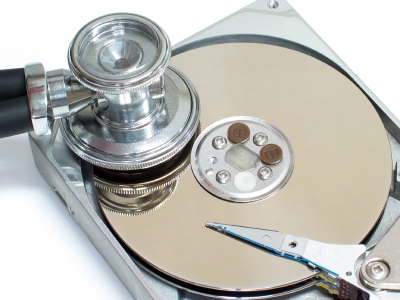It is much more difficult to recover data if a read/write head touches magnetic platter of a hard drive. It happens when a hard drive is subjected to shock since the distance between the head and platters in modern devices is minimal. In its turn, damage of magnetized surface virtually always implies loss of bits stored there. Head can touch the bad surface many times and each time breaking the platter’s fragments. These fragment can stuck inside and scratch hard drive’s surface and cause other troubles. A user will not be able to solve this problem because a head won’t be able to fly over the bad spot.
Overvoltage of read/write head could lead to irreversible damage of areas containing data. Magnetized hard drive will also lead to irreversible loss. Speaking of which, it is not only deleted bits but a mechanical destruction of memory sectors. Sometimes recovery specialists are able to recover data partially (all depends upon a specific hard drive). At the same time troublesome Hitachi drives usually are not subject to recovery: the reason behind it is that the manufacturer prefers not to tell about built-in in it software. Other brands at least provide a possibility to read data from the rest of platters.
Strange and yet a fact: the reason for problems may be even an internal disbalance. Uneven rotation of hard drive platters due to defect bearings will lead to undesirable changes in tracks and the system won’t know about it. As a result we get a data mishmash.
As a rule, bearings or spindle motor failure occurs due to errors during movement or transportation of a hard drive. Experts often get access to data by restoring the balance (by shifting and centring platters).
Logic errors do not require works to be done in a clean room environment. Usually they occur due to mishandling or deleting files against a backdrop of adequate performance of a hard drive.
Even though the source of problems hides in hard drive, probably it is only an ordinary bad sector. Such sectors can be found on all drives: main list contains bad sectors detected at the factory and auxiliary list is being replenished during the device operation — as long as sectors fail. Such divergence occurs quite often and pass for normal, but if the self-diagnostics system S.M.A.R.T. advises to re-save data ASAP, things look blue. Usually it indicates that auxiliary list is full and the number of bad sectors has exceeded the average value.
Now lets talk about irreversible damages. If a drive got in fire or was impacted by another heat source with magnetic material heated up above Curie point, the device will be completely demagnetized. A specific Curie point depends on a hard drive model. In magneto-optic devices the Curie temperature is default (laser heating) but things are different with hard disk drives.
An attempt to solve the problem yourself can make things worse — this is what make the data recovery process so difficult. According to statistics Europeans try to right the ship themselves more often than Americans do. After a number of failed attempts to recover data independently the device is brought to our company and data recovery becomes more complicated and sometimes even not possible. We have already published a number of articles on how to handle a hard drive if it contains important data.
Another reason for complications — employees tend to hide the fact that something is wrong with the device from the boss. We had a case when instead of a damaged hard drive we received a CD-ROM :)

 In our data recovery practice we have faced a variety of hard drive problems. So, in this article we tried to put together the information about different types of HDD damage.
In our data recovery practice we have faced a variety of hard drive problems. So, in this article we tried to put together the information about different types of HDD damage.